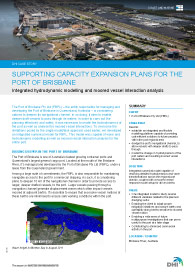Supporting the Port of Brisbane’s capacity expansion plans
In order to help with the Port of Brisbane’s capacity expansion plans, we developed an integrated numerical model for the Port of Brisbane Pty Ltd (PBPL) – the entity that manages and develops the port.
 In order to help with the Port of Brisbane’s capacity expansion plans, we developed an integrated numerical model for the Port of Brisbane Pty Ltd (PBPL) – the entity that manages and develops the port. This model was capable of wave and hydrodynamic modelling as well as moored vessel interaction analysis for the entire port.
In order to help with the Port of Brisbane’s capacity expansion plans, we developed an integrated numerical model for the Port of Brisbane Pty Ltd (PBPL) – the entity that manages and develops the port. This model was capable of wave and hydrodynamic modelling as well as moored vessel interaction analysis for the entire port.
Among a large suite of commitments, the PBPL is also responsible for maintaining navigable access to the port for commercial shipping. As such, it is considering plans to deepen 10 km of the navigational channel in order to provide access to larger, deeper drafted vessels, to the port.
PBPL made the strategic decision to contract DHI to develop an integrated numerical model capable of being utilised for a wide range of applications relevant to the port’s ongoing capacity planning and management. A regional wave model was also included to complete the foundation for a wide array of multipurpose investigations that could be useful to the port at a later stage – at a greatly reduced capital cost.
The hydrodynamic modelling was undertaken using our two-dimensional (2D) hydrodynamic flow model, MIKE 21 FM – a key component of our MIKE by DHI software suite. Moreover, there was a moored vessel analysis component, which included a detailed assessment of the expected increase in moored vessel interaction along all key vessel berths identified by PBPL.
Our solutions helped by:
- enabling the client to adopt proper mitigation initiatives and assure safety and operability along berths sensitive to moored vessel motion
- enabling a wide array of future multipurpose investigations that can prove useful to the port at a later stage
- contributing to enhanced commercial activity in the port
Read more